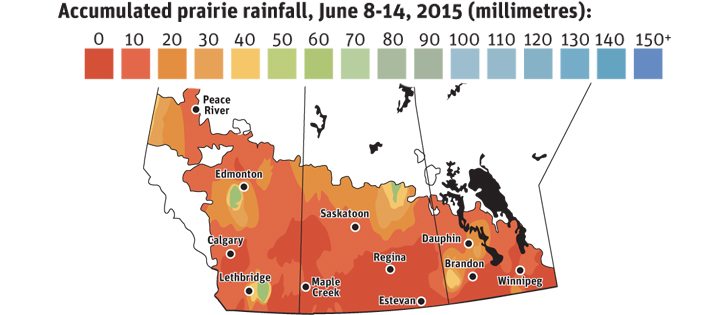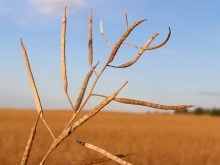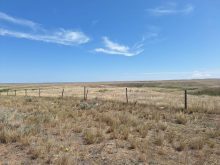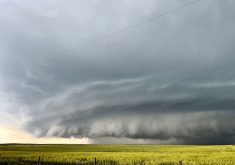Some prairie farmers must be feeling like they’ve won the lottery with scattered showers and good solid rain.
For others, however, problems continue. Last weekend’s weather brought grey skies and strong winds but only a few drops of rain in many places.
“It was sporadic,” said Environment Canada meteorologist Dan Kulak.
Rain across the Prairies ranged from nothing to 25 millimetres. More rain was predicted for this week, after the newspaper’s production deadlines. If those forecasts prove true, it would further buoy farmers’ optimism about their crops this season.
Read Also

Using artificial intelligence in agriculture starts with the right data
Good data is critical as the agriculture sector increasingly adopts new AI technology to drive efficiency, sustainability and trust across all levels of the value chain.
However, many regions remain in need of more moisture.
Elk Island, just east of Edmonton, received 16 mm from June 12-15, Fairview received 21 mm and Seven Persons, in southern Alberta, received nine mm. North Battleford received one mm and Spiritwood, just to the north, received 27 mm.
“It was not exciting amounts. Probably just enough to dampen the dust,” said Kulak.
Central Alberta received the biggest boost from the weekend rain with widespread thunder showers.
“Locally we’re not too bad,” said Terry Young of Lacombe, Alta.
His farm received 28 mm of rain, while much of the surrounding area received 19 mm, which helped parched crops.
“The crop has actually bounced back pretty good,” said Young, who added that crops were starting to look stressed.
“It’s positive right now. If you phone back in two weeks and we don’t have any more moisture, I may be in a bit more of a panic mode.”
Norm Hennigar of Grande Prairie, Alta., said the 25 mm of rain over the weekend perked up pastures, hayland and everyone’s spirits.
“We’re not really suffering. With that rain, we’re sitting OK,” he said.
Hennigar said he wouldn’t turn down another 75 to 100 mm of rain to give cereal and oilseed crops and hayland an extra boost.
Hay yields may have been the crop most affected by the earlier dry period.
Merle Jacobson, chief operating officer with Alberta Financial Services Corp., said livestock producers were concerned about the dry conditions, but drought claims for insured hay crops weren’t widespread.
The provincial government agency worked with livestock producers after the droughts of 2002 and 2009 to change the rules around hay insurance and eliminated the rule that penalized cattle producers for grazing their insured hay crops.
“We don’t want to get in the way of management decisions,” said Jacobson.
Farmers can put up an enclosure in the insured hay field after contacting AFSC and graze the rest of the field.
The rules were changed four years ago, but some producers still believe grazing their hayland would void their hay insurance.
Only 290,000 of Alberta’s six million acres of hay and pasture are insured through AFSC.
Instead, Jacobson said many farmers self-insure by stockpiling hay from previous years or carrying over grass to maintain enough feed for their cattle.
As of June 12, farmers had made 34 hay insurance claims for dry conditions.
There were only 400 claims for reseeding despite late season frost in parts of the province, which was fewer than previous years. There have also been fewer hail claims than previous years.
Farmers had made 160 hail claims as of June 12, compared to about 1,000 up to the same time in previous years.
Jacobson said all farmers would like more rain, but no one has yet declared this year’s dry season a drought.
Shannon Friesen, cropping management specialist with Saskatchewan Agriculture, said rain in her province was sporadic but helped crops and hayland where it fell.
“For the most part, we need a good general rain across the entire province,” she said.
As in Alberta, some of the rain came with hail, which hurt more crops than it helped.
“The rain has helped replenish that subsoil moisture,” she said.“It’s not dire just yet, but the longer we go without showers the worse it will be.”
Dwane Morvik of Eastend, Sask., said the weekend showers skirted around his southern Saskatchewan ranch.
“We had about 13 drops,” said Morvik, who watched the dark clouds roll by without producing rain.
“It’s pretty dry.”
No good general rain means pasture and crop growth depends on luck. A nice shower on one field doesn’t mean it rains five or 10 kilometres away.
Morvik said rain early in the season allowed his grass to get a good start, but a lack of rain since then has halted growth.
Native pasture headed out two weeks ago, and hay growth ground to a halt in the area.
Morvik said he hasn’t made big decisions to sell animals early and is still hoping for rain to restart pasture growth. He has begun flood irrigation in the valleys for hay production.
Producers without new hay stands or access to irrigation will soon struggle to find enough grass or hay, he added.
A June 12 thunderstorm in Manitoba brought much-needed moisture to the western part of the province, but some areas received an excessive amount of rain and some hail, which damaged canola and other crops in the region.
David Wray, who farms north of Birtle, said the storm dumped 50 to 75 mm of rain on his cropland.
Like many other producers in western Manitoba, Wray needed rain but not 75 mm in a matter of hours.
“We were dry, but the amount that we had (in a short time), we might have been better off to stay dry,” he said.
A late May frost forced Wray to re-seed a portion of his canola in early June. Those plants had just emerged when the storm arrived.
Wray’s fields now have standing water, but the storm was harder on other farmers around Birtle. Hail damaged immature crops in the area, possibly wiping out some fields.
Jeff Kostuik, who works for Manitoba Agriculture in Roblin, said the storm delivered substantially less precipitation northwest of Riding Mountain National Park.
He said Roblin received five to 10 mm of rain.
“(We) certainly could use more in the Roblin area, especially that re-seeded canola,” he said.
“Everything else that has got the root structure started may be doing OK. Any of the reseeded canola could be suffering from a lack of moisture.”
Larry Bohdanovich of Grandview said his farm received 15 mm of rain June 12, which was not quite enough but still welcome.
“Crops really looked a lot different Saturday and Sunday (June 13-14),” he said. “Right now we’re good for four to five days, or a week.”
Wray would have preferred a less intense rain in early June, but he realized it may benefit his crops over the long haul.
“Right now it looks the worst, but by fall time it might be a different story.”
Lack of moisture hasn’t been an issue in most parts of central or eastern Manitoba this spring because rain fell on those regions in early June.















